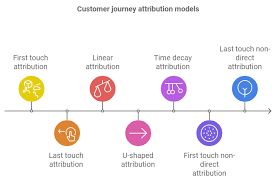In today’s world, a customer rarely converts after just one interaction. They might see an ad, read a blog, watch a video, and compare prices before buying. Multi-Channel attribution helps you understand this complete path and gives you data-driven insight to improve your marketing strategy. Without it, You’re simply guessing which channel worked best.
This strategy is essential for digital marketers who want to maximize ROI, improve conversion rates, and understand their audience better.
In this blog we’ll share with you all the key information about what is Multi-Channel attribution and how does it works, and also about its benefits.

What is Multi-Channel Attribution?
Multi-Channel Attribution is a digital marketing technique that allows businesses to analyze and assign credit to various marketing channels that contribute to a customer’s purchase journey. When a customer interacts with a brand through various platform such as clicking on a Facebook ad, searching on Google, or opening an email, each of these interactions is called a “touchpoint”.
Multi-channel attribution helps marketers understand hoe these touchpoints collectively influence a customers final decision to but a product or take action.
In traditional marketing, credit was often given only to the last interaction (known as last-click attribution), but this method ignores the role of earlier channels that led the customer there. With multi-channel attribution, we look at the entire journey and give each channel the fair share of credit it deserves.
A Real-World Example of Multi-Channel Attribution
Let’s imagine a customer named Jolly who is looking to buy a skincare product online.
Jolly Buying Journey:
1. Awareness (Instagram Ad)
Jolly is scrolling by Instagram and sees a beautiful ad for a skincare brand called Glow & Pure. She clicks the ad and browses the website, but does not buy anything.
2. Interest (Google Search)
A few days later, Jolly searches on Google: “Best moisturizer for dry skin”. She sees Glow & Pure website in the results again and clicks it.
3. Consideration (YouTube Video Review)
She later watches a skincare influencer’s review of Glow & Pure products on YouTube, who shares a positive experience.
4. Reminder (Email Campaign)
After signing up for a 10% discount on the website, Jolly receives an email from the brand with a coupon code.
5. Conversion (Direct Visit)
Finally, she decides to purchase. She types the website URL directly and buys the product using the coupon code.
So, this is here multi-channel attribution comes in. Other then of crediting just one touchpoint, this supports us understand the part every channel played in Jolly decision to subscribe.
Types of Multi-Channel Attribution Models?

Multi-channel attribution models are methods used to assign credit to various touchpoints (interactions) that a customer has with a brand before converting (making a purchase, filling a form, etc.). Each model offers a different way to understand the effect of various marketing efforts.
First-Touch Attribution
This model gives 100% of the conversion credit to the very first touchpoint the user had with your brand.
Use Case: Best for businesses focusing on brand awareness and lead generation.
Example: A user clicks on a Facebook ad (first interaction), later visits the site via email, and finally makes a purchase. In this model, Facebook Ad gets all the credit.
Last-Touch Attribution
This model assign 100% of the credit to the last interaction the customer had before converting.
Use Case: Ideal for evaluating the final push that drives conversions.
Example: A user visits through an organic search, sees a retargeting ad, and finally clicks an email to purchase. The email campaign gets full credit.
Linear Attribution
This model distribution credit equally over all the channels the customer interacted with before converting.
Use Case: Suitable when every touchpoint is considered equally important in the customer journey.
Example: If a user engage with Facebook, Google, and Email, each channel gets 33.3% of the credit.
Time Decay Attribution
This model provide more credit to recent touchpoints and less credit to earlier ones in the journey.
Use Case: Useful for short sales cycle or time-sensitive promotions.
Example: A customer’s first interaction was via a blog, then a social ad, and finally an email. The email will receive the highest credit, while the blog gets the least.
Position-Based Attribution
This model assign:
40% credit to the first interaction
40% to the last interaction
The remaining 20% is split equally among the middle interactions.
Use Case: Best for recognizing the value of both brand discovery and conversion action.
Example: If the journey includes Facebook > Blog > YouTube > Email:
Facebook = 40%
Email = 40%
Blog + YouTube = 10% each
Data-Driven Attribution
This model uses machine learning and real data to determine which touchpoints actually contributed to the conversion and how much. It analyzes patterns across multiple conversions to assign credit dynamically.
Use Case: Ideal for advanced marketers with access to large volumes of data (like through Google Ads or analytics platforms).
Example: Based on Past behaviors, the model may find that users who engage with video and search ads convert more, so it allocates more credit to those channels automatically.
Benefits of Multi-channel Attribution
Below are the key benefits of multi-channel attribution:
1. Boost Return on Investment (ROI)
One of the most significant benefits of multi-channel attribution is that it supports businesses improve their marketing ROI. By analyzing how different channels contribute to a conversion, marketers can identify which campaigns or platforms are performing well and which ones are not. This permits for better allocation of budget, ensuring that money is spent only on high-performing channels. As a result, businesses can reduce wasted spend and increase overall profitability.2. Deeper Understanding of the Customer Journey
Multi-channel attribution gives a detailed view of the entire customer journey. Instead of focusing only on the first or last interaction, it shows how multiple channel work together to lead a user toward conversion. This comprehensive view helps marketers understand user behavior, preferences, and decision-making processes, making it easier to create more effective marketing strategies.3. More Accurate Credit Allocation
Traditional Model like last-click attribution give all the credit to the final interaction, ignoring earlier touchpoints. Multi-channel attribution solves this problem through fairly distributing over all important touchpoints. This gives a more realistic picture of how different marketing efforts contribution to success, permitting marketers to evaluate each channel’s true impact.4. Better Channel Optimization
When you know which channels play crucial roles in the conversion path, you can focus on optimizing them. Multi-channel attribution makes it easier to refine your strategy for SEO, social media, email marketing, paid ads, an other platforms. This means you can boost performance over the board by tailoring your messaging, timing, and targeting based on real user data.5. Increase Decision-Making Through Data
Multi-channel attribution helps data-driven decision-making. Instead of guessing which marketing efforts are working, you rely on actual performance datafrom various channels. This leads to more confident decisions, better campaign planning, and more effective use of marketing resources.
6. Competitive Advantage
Businesses that adopt multi-channel attribution gain a competitive edge by making smarter, more informed marketing decisions. They can respond faster to change in consumer behavior, optimize their strategies more effectively, and outperform competitors who depend on outdated attribution models or guesswork.7. Strengthens Cross-Channel Strategy
Multi-channel attribution encourages an integrated marketing approach. It reveals how different channels interact and influence each other, allowing marketers to design cross-channel campaigns that are more cohesive and impactful. This reduces siloed efforts and builds a more unified brand presence across all platforms.8. Better Customer Experience
Understanding the full journey also helps in creating a better customer experience. When marketers know how and when users interact with different channels,they can deliver more personalized and relevant messages. This can lead to higher user engagement, trust, and satisfaction, increasing the chances of conversion and long-term loyalty.
Executing Multi-Chanel Strategies-Step-by-Step Guide
Here are executing multi-channel strategies for marketers and businesses:
Define Clear Business Goals
Before diving into any attribution model, the first step is to define what success looks like for your business. Are you aiming to increase sales, generate leads, boost sign-ups, or drive traffic? Having clearly define conversion goals helps guide your attribution approach ad ensures that your strategy aligns with your general marketing objectives. Without clear goals, measuring performance accurately becomes difficult.
Map the Customer Journey
Understanding your customer journey is essential for successful multi-channel attribution. Identify the key touchpoints where your audience interacts with your brand-such as paid ads, organic search, social media, email efforts, or content marketing. Mapping this journey permit you to see how users move across channel before converting, which is crucial for assigning credit correctly.
Select the Right Attribution Model
Choosing the appropriate attribution model depends on your business type, goals, and sales cycle. For example:
- First-click attribution is useful for measuring awareness campaigns.
- Lat-click attribution works for short decision-making journeys.
- Linear or time decay models suit longer, multi-step journeys.
- Data-driven attribution is ideal for larger businesses with sufficient data for machine learning.
Selecting the right model helps distribute credit fairly and improves decision-making over your marketing strategy.
Use the Right Tools and Analytics Platforms
To implement attribution successfully, use analytics platform that helps multi-channel tracking. Google Analytics 4 (GA4), Adobe Analytics, HubSpot, or marketing automation tools are all supports for this purpose. These platform allow you to track user behavior across channels and apply attribution models that reveal the true contribution of each touchpoint.
Track and Tag All Marketing Channel
Consistent tracking is vital. Make sure every marketing link is properly tagged using UTM parameters (for Google Analytics) so that you can accurately attribute traffic and conversions to the right source, medium, and efforts. Without proper tagging, some touchpoints may go untracked, leading to incorrect attribution and misleading data.
Collect and Analyze Data Regularly
Multi-channel attribution is not a one-time task. You need to collect, monitor, and analyze data regularly. Look for patterns and insights to understand which channels and combinations lead to the highest conversion rates. This ongoing process helps in refining campaigns and improving overall marketing efficiency.
Test and Adjust Attribution Models Over Time
A your business grows and customer behavior changes, your attribution model might need adjustments. Continuously test different models and strategies to see which gives you the most accurate view of performance.
Optimize Based on Attribution Insights
Once you start gathering insights, use them to optimize your marketing efforts. If your attribution data shows that email efforts are driving strong conversions after an initial paid ad click, you might want to increase investment in both areas. Use attribution data to adjust budget, improve massaging, and time your efforts better for maximum impact.
Stay Updated with Technology and Trends
Digital marketing is always evolving, and so are attribution techniques. Stay updated with changes in tools like Google Analytics, cookie tracking limitations, and privacy regulations. Adapting to these changes early ensures your attribution strategy remains accurate and compliant.
Through executing multi-channel attribution strategies, businesses can get complete information about customer journey. Above all strategies will be beneficial for marketers and businesses growth.
Which Multi-Channel Attribution Model is best?
The most powerful and reliable multi-channel attribution model today is Data-Driven Attribution (DDA). Unlike traditional models that assign fixed credit percentages to touchpoints, DDA uses machine learning to analyze actual user behavior over all your marketing channels. It evaluates how each interaction
contributes to a conversion and dynamically distributes credit based on real impact. This means it takes into account the position, frequency, and effectiveness of each channel in the path to conversion-providing a more realistic picture of what’s truly working. It eliminates guesswork and gives marketers precise insights to optimize budget allocation and boost efforts performance.
Data-driven attribution is especially effective for businesses with high traffic, longer sales cycles, or multiple touchpoints. It works best when integrated with tools like Google Analytics 4, which automatically learns from your data to assign credit fairly.
Wile it requires a solid volume of data to be effective, it offers unmatched accuracy, making it the most recommended model for businesses aiming for smart, data-backed marketing decisions.
How does multi-channel attribution differ from single-touch attribution?
Multi-channel attribution and single-touch attribution differ in how they assign credit for conversions across a user journey. Single-touch attribution models such as first-click or last-click give 100% credit to only one interaction in the customer journey.
For example, if a user first clicks on a Facebook ad, then visits via a Google search, and finally converts after clicking an email, a single-touch model would only credit either the first or last click. This oversimplifies the decision-making process and can mislead marketers about which channels are truly performing.
On the other hand, multi-channel attribution recognizes that modern consumers often engage with multiple touchpoints before converting. It distributes credit across all meaningful interactions-whether equally (linear model), based on timing (time decay), or intelligently using algorithms (data-driven attribution). This approach gives a more complete and accurate view of the entire customer journey, helping marketers understand how different channels work together to drive results.
By using multi-channel attribution, businesses can make better-informed decisions, optimize campaigns more effectively, and invest in the right channels for growth.
Conclusion
In conclusion, complete understanding about multi-channel attribution is important for businesses to measuring the effect of different channels of marketing on their businesses growth and success.
Multi-channel attribution is a strategic approach in digital marketing that helps businesses understand how different marketing channels contribute to a customer decision to convert. Instead of giving full credit to just one touchpoint, it looks at the “entire customer journey” from the first interaction to the final conversion and “distributes credit over multiple channels” like social media, email, paid ads, and organic search. This allows marketers to identify which channels are truly effective and hoe they work together to influence behavior.
By using different attribution models such as linear, time decay, position-based, or data-driven businesses can monitor and optimize their efforts based on real insights. In short, multi-channel attribution empower brands to make smarter, data-backed decisions, boost ROI, and create more impactful marketing strategies by focusing on what actually drives results.





